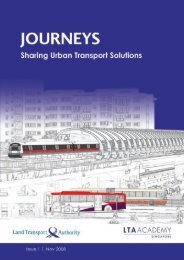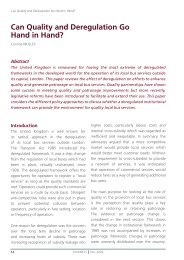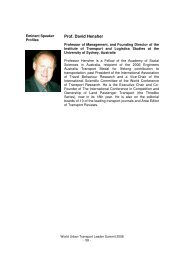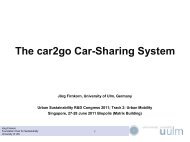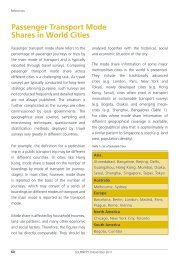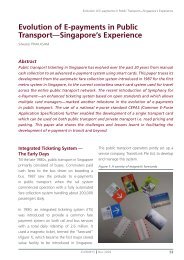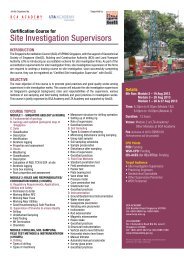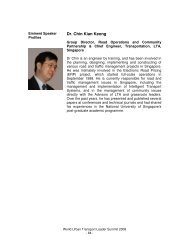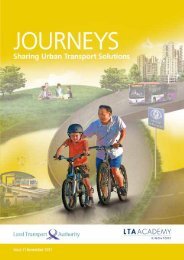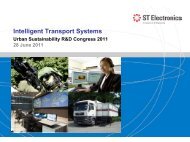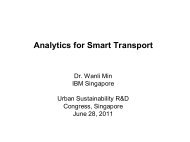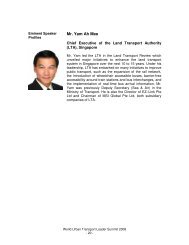Issue 4 May 2010 - LTA Academy
Issue 4 May 2010 - LTA Academy
Issue 4 May 2010 - LTA Academy
Create successful ePaper yourself
Turn your PDF publications into a flip-book with our unique Google optimized e-Paper software.
Proactive National Transport Strategy for Low Carbon and Green Growth in Korea<br />
The charge has reduced 12,000 vehicles per<br />
day at Seoul downtown, which is 13.3 %<br />
of total downtown traffic volume. More<br />
elaborate congestion pricing schemes should<br />
be developed, based on emission produced by<br />
each vehicle type and travel speed, in order<br />
to reduce congestion-related externalities and<br />
environmental burdens.<br />
Parking policy<br />
Previously, the core of Korea’s parking policy<br />
was to provide adequate parking for every<br />
building and facility. This thinking is about to<br />
be reversed and decreased parking spaces in<br />
the CBD is being considered so as to reduce<br />
the influx of private passenger cars into Korea’s<br />
cities. On the other hand, park-and-ride<br />
facilities have been continuously constructed.<br />
Parking-related charges should be employed<br />
in order to better reflect the cost of providing<br />
and maintaining parking spaces, as well as<br />
the externalities caused by the use of private<br />
passenger cars.<br />
Modal shift in freight transport<br />
and green logistics<br />
The freight transport sector accounts for<br />
31% of the total transport CO emissions and<br />
2<br />
it is also regarded as the most inefficient of<br />
Korea’s transport sectors. In particular, less<br />
efficient private freight vehicles dominate the<br />
sector. The government is now establishing<br />
a plan to reduce freight’s dependency on<br />
the road sector and to increase the capacity<br />
of the freight rail, a more energy efficient<br />
and environmentally friendly way to move<br />
the nation’s goods. This sector can also be<br />
made more efficient through policies such as<br />
14<br />
JOURNEYS <strong>May</strong> <strong>2010</strong><br />
green logistics certification, which provides<br />
incentives to logistics firms to reduce energy<br />
consumption and GHG emissions.<br />
Parking-related charges should be<br />
employed in order to better reflect<br />
the cost of providing and maintaining<br />
parking spaces, as well as the<br />
externalities caused by the use of<br />
private passenger cars.<br />
Conclusion<br />
Greening of the current transport system<br />
requires a long term vision and multifaceted<br />
approaches. Land use and urban design<br />
should reflect energy and environmental<br />
considerations. Technologies should also<br />
be promoted and economic incentive<br />
schemes should be provided not only for<br />
the technological developments but also for<br />
behavioural changes in transport demand<br />
and usage.<br />
Transforming our transport system into a low<br />
carbon and environmentally friendly one would<br />
provide many opportunities for green growth<br />
and also indispensable infrastructure for<br />
sustainable economic growth and prosperity.<br />
A legal framework is required in order to<br />
facilitate the transition to green transport<br />
systems. Investments on transport infrastructure<br />
should be guided by a revised assessment<br />
methodology which takes the environmental<br />
benefits and cost into full consideration.



